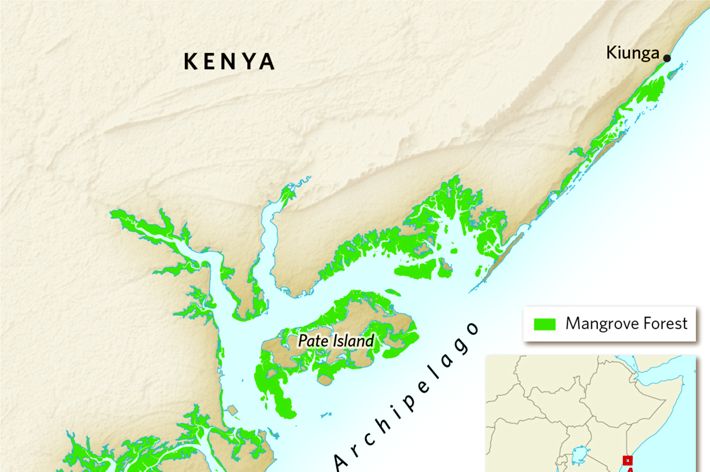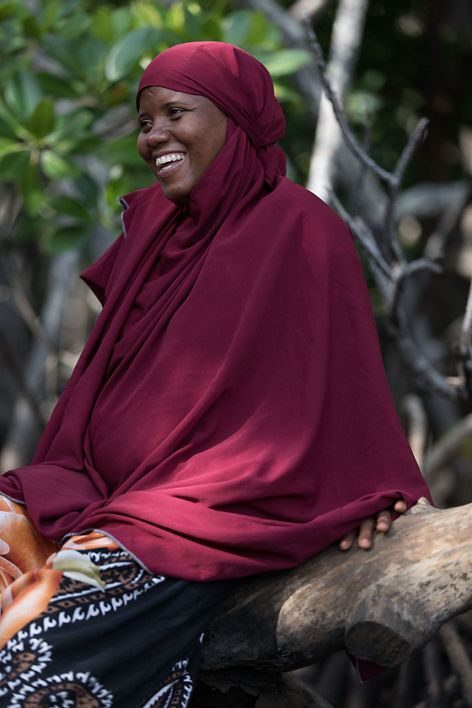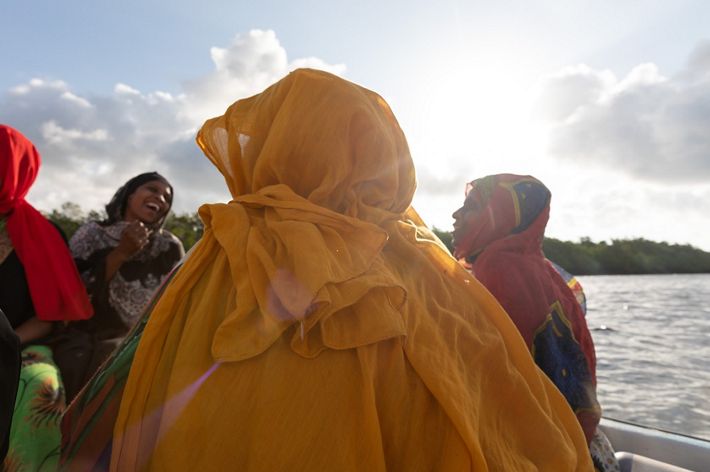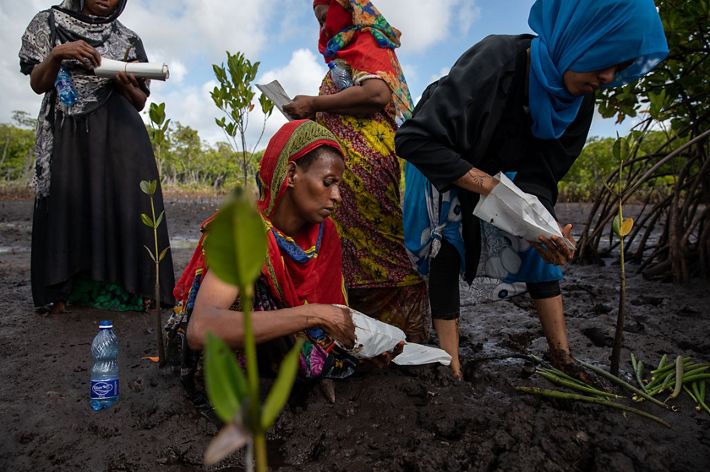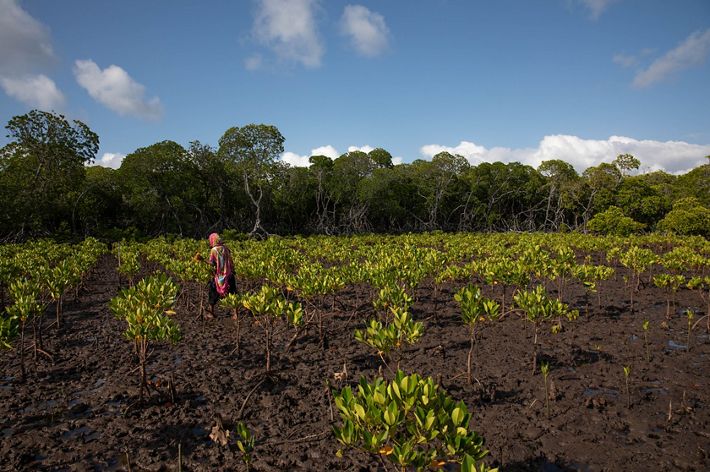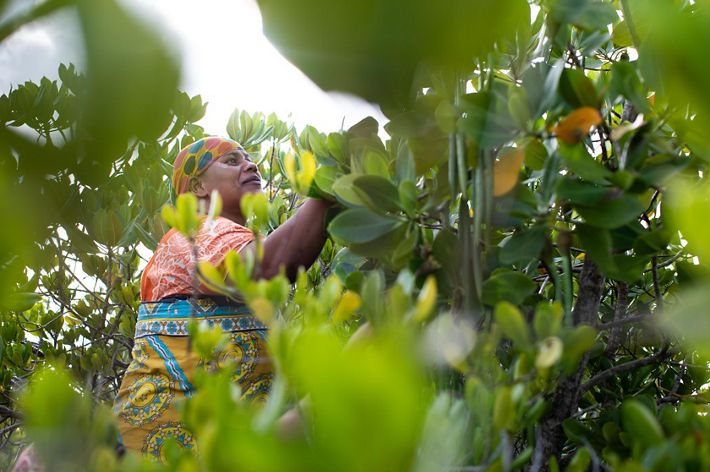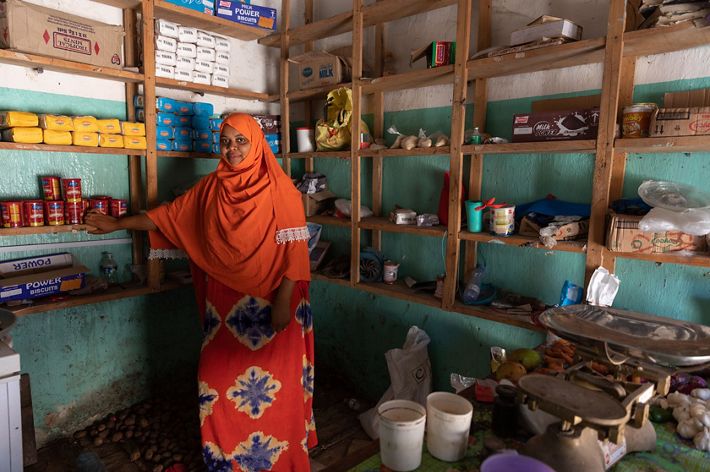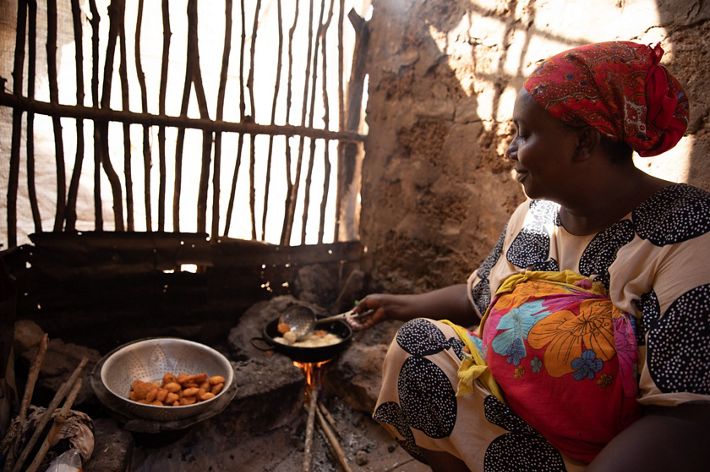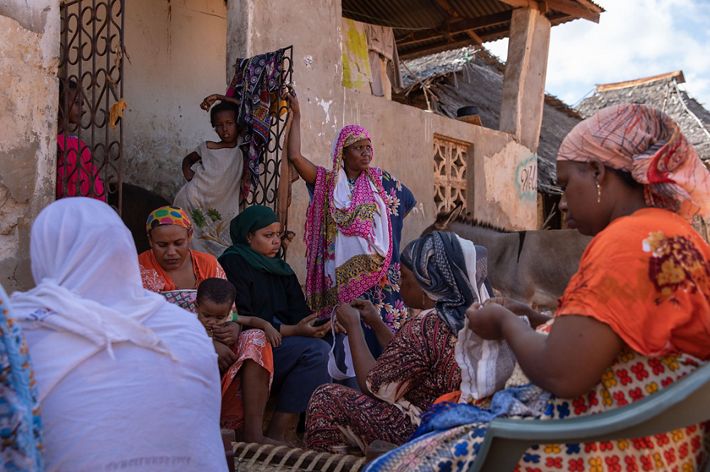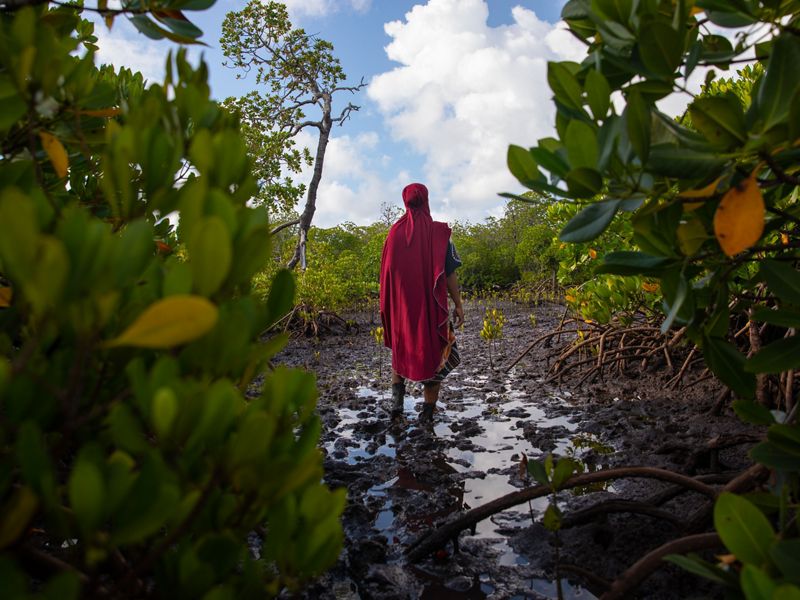
Plantation Zulfa Hassan, founder of the Mtangawanda Women’s Association, stands in the mangrove plantation that she and the group restored and manage. © Sarah Waiswa
When Zulfa Hassan goes to work, she carries the seedlings of a future forest. She plants the new trees one by one where a tropical mangrove forest once grew on Kenya’s Pate Island. It’s not hard to imagine that this barren patch of coastal wetland will again be a lush tangle of life.
Working while the tide is low, she and the women alongside her handle the tender seedlings with care. They dig holes with bare hands in the saturated soil, spacing the plantings a few feet apart and giving each one the elbow room it needs to start a new life.
Most Fridays, the women trade the bustle of village life for the quiet coastal forest nearby. Dressed in brightly colored hijabs, their voices, easy laughter and singing mingle with birdsong. Hassan, an energetic 33-year-old mother of four, is the elected leader of the Mtangawanda Women’s Association, which she helped to establish four years ago to restore mangroves around her community. She has come to be known as Mama Mikoko—“Mother Mangrove” in Swahili.
The fishing communities of Kenya’s Lamu Archipelago have always relied on their mangrove forests. The spindly looking trees provide wood for homes and for boat building. Yet for many years, Hassan says, the forests were being cut down too quickly by outsiders. “We knew loggers cut mangroves to get money but didn’t realize they are destroying mangroves in the process,” Hassan says. It was commonly thought that the mangroves would regrow on their own, but demand for the wood outpaced the trees’ ability to replenish the forest.
Losing mangrove forests then brought on other troubles, like eroding shorelines and dwindling fish and crab populations. So when Hassan began to restore those lost mangroves, she knew it would be an encouraging sign for people in her community.
“Our work is bringing hope,” Hassan says. Now with 30 members, the women’s association has started a tree nursery and planted more than 50,000 seedlings, helping to restore more than 30 acres of mangroves. And in this tradition-bound society in a remote part of Kenya near the border with Somalia, the work of planting trees, nurturing forests and watching over their management is broadening women’s roles by offering them an opportunity to reshape certain aspects of community life. As Hassan says, “It has also brought us women together.”
Because of evolutionary adaptations that allow it to thrive in saltwater marshes, a mangrove seems like something more than a tree, and where they grow in tangled profusion, they add up to something more than a forest. They grow in the soil but the daily rise and fall of the tide floods their roots. This means mangroves are part of the sea as well as the land. While birds roost in their leafy branches, young fish and crabs find safety in the interlocking network of roots.
On Pate Island, the largest isle in the Lamu Archipelago, mangroves provide medicine, firewood and forage for cattle. Bees draw nectar from trees in bloom, producing a delectable mangrove honey. Traditional Swahili architecture, with its beautifully carved doors and lintels, uses mangrove wood in beams and roofs. And in these communities where fishing the sea is a way of life, the mangrove’s role as a nursery for sought-after species such as crab and mangrove snapper is universally understood.
“Mangroves are part and parcel of their lives,” says George Maina, The Nature Conservancy’s fisheries strategies manager in Africa. “The landscape is a collection of small islands, all of them with mangroves and communities mostly depending on fishing as a livelihood. And if there are no mangroves, then ... fish productivity goes down. So there’s a great connectivity in terms of ecosystems, from mangroves to sea grasses to coral reefs, to open seas and to the life of the community.”
Beyond their local importance, mangroves have been identified as an important species for battling climate change. They sequester up to five times more carbon than trees growing on land, attributed in part to the way their roots trap carbon-rich organic matter in the saturated intertidal soils. Recognizing this, Kenya in 2020 incorporated the management of mangrove forests into its enhanced Paris Agreement emissions-reduction target.
But from 1995 to 2014, Kenya’s northern coast lost about 20% of its mangroves, according to research co-authored by TNC’s Maina and a team of scientists. Some loss was due to illegal tree-cutting, and coastal development also contributed to the decline. Yet the researchers say the region’s mangrove forest can thrive with careful management, sustainable use and the involvement of people who are committed to making the right decisions for the future of the forest—people such as Hassan and the Mtangawanda Women’s Association.
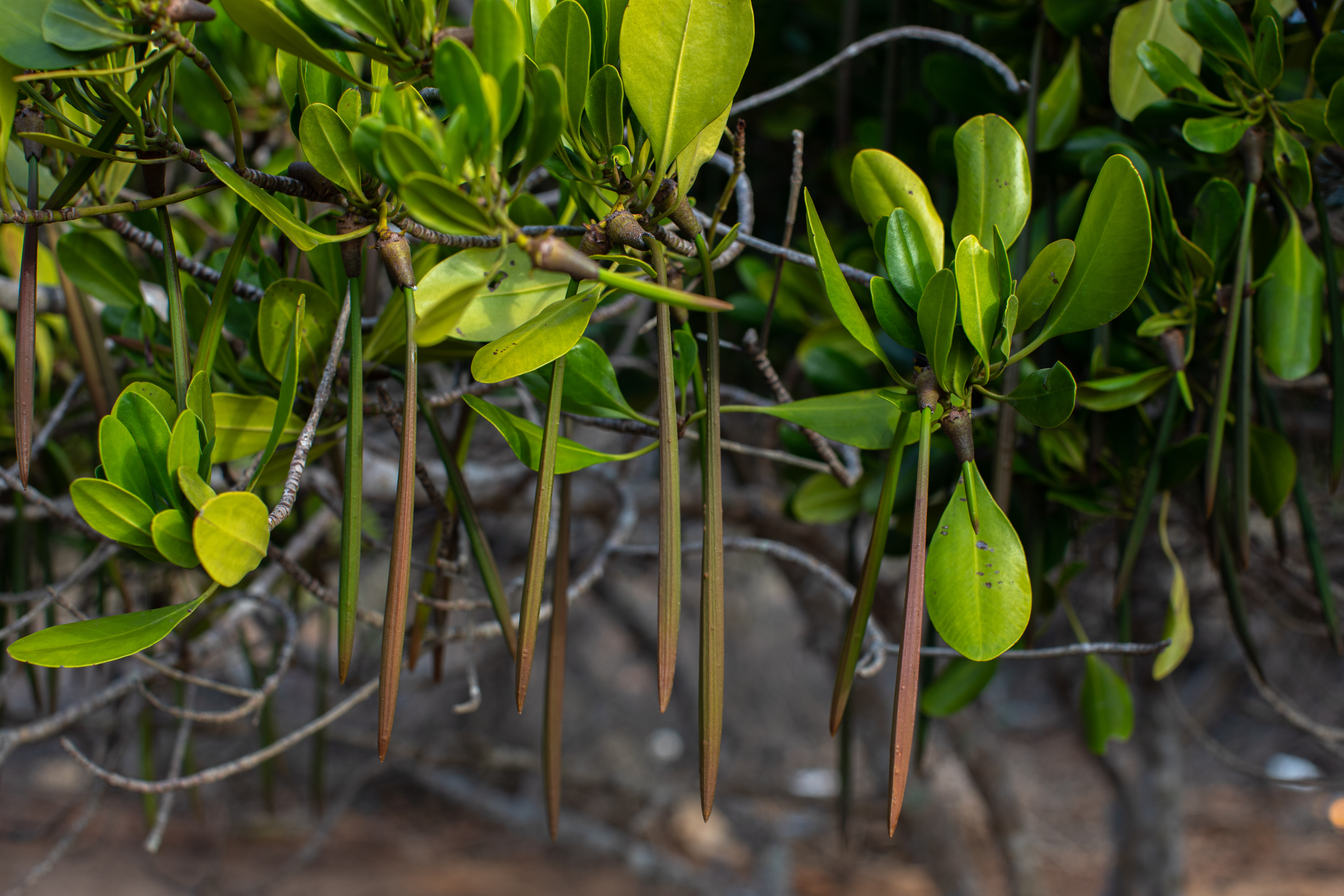
Saving the Supertrees
Approximately 70 species of mangroves range across five continents, but figures from a 30-year period ending in 2010 show the planet’s mangroves declined by as much as 35%. They’ve been cut down to make way for the growing footprint of cities, industry and agriculture or lost to effects of climate change such as sea-level rise. Some forests suffer from changes in river flows that upset the ecological balance necessary for life at the edge of the sea. Scientists have expressed alarm at the decline, though data show the rate of loss has slowed in recent years. This comes at a time when the carbon-storing ability of mangroves is more critical than ever. By sequestering tremendous amounts of carbon not only in their woody trunks but also in wet soil, mangroves store, in sum, up to five times as much carbon as tropical rainforests. This makes them supertrees with a supersized role for the planet. And that’s why TNC is working in many different countries to restore mangroves.
Caribbean: A new mangrove-restoration project in Jamaica is the result of the innovative Resilient Islands partnership with the International Federation of Red Cross and Red Crescent Societies. As people in the Caribbean face more frequent and destructive hurricanes caused by climate change, this partnership promotes nature-based solutions to protect people, livelihoods and coasts.
Indonesia: This country has more mangroves than anywhere else in the world. While mangroves comprise just 2.6% of Indonesia’s forests, their protection and restoration can provide 6% of the nation’s carbon emission reduction goals. Through the Mangrove Ecosystem Restoration Alliance, TNC and its main partner, Yayasan Konservasi Alam Nusantara, are trying to help reverse Indonesia’s trend of mangrove deforestation.
Papua New Guinea: The Conservancy is working with the women’s network Mangoro Market Meri—”Mangrove Market Women”—to advance gender equity and prepare new pathways for women to protect mangroves and develop sustainable business ventures that provide incentives for local conservation measures.
Florida: The Conservancy is advancing natural coastal infrastructure strategies to reduce reliance on “gray infrastructure” such as concrete seawalls. Nature-based solutions such as mangrove forests can protect people and property while providing an array of benefits to people and nature.
To bring mangroves back, a partnership of the Northern Rangelands Trust, the Kenya Forest Service, Kenya Marine and Fisheries Research Institute, TNC and others suggested a path forward in 2018. The formation of women’s associations was partly informed by a learning exchange in Madagascar. So far, the partnership has helped establish the Pate-Ndau-Awer and Lamu Mangrove community forest associations—organizations in which the women’s associations are actively involved.
These mangrove forests are owned by the Kenyan government, but the forest associations are leading the community’s effort to craft a formal agreement with the Kenya Forest Service to shift management into the hands of local people. Hassan says local management, through the formation of a community forest association, is a necessary first step in exploring carbon trade initiatives, which have rewarded some communities for adopting sustainability commitments.
Maina explains that for conservation to be successful in communities where people directly rely on the nature around them, solutions must look beyond the most visible problems, such as the loss of nursery habitat and associated declines in fish populations. In this case, Maina says, the big-picture approach to the conservation of forests and fisheries begins in the home.
“We need to think outside the box by also coming and addressing issues at the household level,” Maina says. Empowering women with new leadership and earning opportunities can reduce a family’s dependence on the harvest of struggling fisheries and shift local practices toward sustainability. “We know the power of the women,” Maina says. “They can change the mindset at home.”
As part of the agreement, TNC’s partner Northern Rangelands Trust set up a microloan program for women who participate in mangrove restoration. These loans are often used by women to establish home-based businesses of their own.
When the Mtangawanda Women’s Association began, however, local support wasn’t universal. It was uncommon for women to take on roles in the community outside the home. Hassan says she heard questions like, “‘Why don’t you just stay in your homes and do normal women chores [rather] than going out to the mangroves?’” But over time, as their mangrove plantings increased, so, too, did respect for the women’s efforts. Local fishers are noticing new life emerging in the replanted areas. “Nowadays fishers tell us that they pass by our plantations and see crabs sleeping,” Hassan says.
Hassan and the other women have come a long way since they first joined the mangrove program. The women’s group helps in surveying potential restoration sites. On some days, they will collect propagules—seeds that germinate on mature trees, fall off and eventually settle into soft, muddy soil to create new roots. The propagules are taken to plant nurseries set up by the women. When the propagules form mangrove seedlings, the women’s group will plant them at the restoration sites.
The group became such experts at managing their mangroves that they started training visitors who are launching mangrove associations of their own. Five trainers from Mtangawanda earn about $300 per month—significant income that can help to pay for family priorities like children’s school fees.
“I don’t want my children to face the same challenges I had growing up with regards to education as a result of poverty,” Hassan says. The women’s association started offering training on financial planning and saving. Empowered with the microfinance loans and the financial training, members of the Mtangawanda Women’s Association are drastically changing their roles in the community.
For Fatuma Athman Mohamed, a 24-year-old mother of two, the money she’s received through the mangrove partnership has changed her life. Through two loans, the equivalent of about $200 and $400, she has built and grown a small shop connected to her home. She sells a sundry mix of household essentials: groceries like sugar and flour, and bottles of gasoline. Her business is ready for its next upsizing, which she hopes to finance through another small loan from the mangrove project. In all, 30 women have been awarded microfinance loans to support small business ventures.
The new feeling of empowerment that women like Hassan and Mohamed describe, the earnings and opportunities to learn and to send their kids to school and restore mangrove forests are all welcome changes. And naturally it all springs from the utility of the mangrove, the tree that has been a source of life for generations past and, now in new ways, will support those to come.
Get the Magazine
Sign up to become a member of The Nature Conservancy and get the magazine.
Subscribe Now